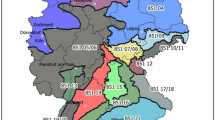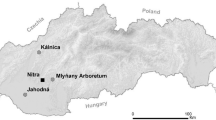Abstract
Since the beginning of the 20th century, pine trees in Japan have been seriously damaged by the pine wilt disease. This disease is caused by the pine wood nematode, Bursaphelenchus xylophilus, which is transmitted by the Japanese pine sawyer, Monochamus alternatus. The control of disease depends to a large extent on chemicals, but the public is now demanding environmentally friendly control methods. The virulence of B. xylophilus varies very widely. Pre-inoculation of young pine trees in a nursery with avirulent B. xylophilus has induced systemic resistance of trees against a subsequent inoculation with virulent B. xylophilus. This induced resistance was considered a hopeful means for developing a biological control for the disease. The induced resistance by the avirulent nematodes was also expressed in mature pine trees in a forest where the disease was naturally epidemic. However, the effects of induced resistance were not satisfactory for practical biological control. Since the inoculation with higher concentrations of the avirulent B. xylophilus induced the resistance more effectively, the pre-inoculation method will need to be improved to develop the biological control. The induced resistance of pine trees by avirulent B. xylophilus should be one of the candidate biological control methods against pine wilt disease. This induced resistance also provides an experimental system to clarify physiological interactions between the nematodes and pine trees.
Similar content being viewed by others
References
Aikawa T and Kosaka H (1998) Difference in multiplication between the virulent and avirulent isolates of Bursaphelenchus xylophilus. Proceedings of 24th International Nematology Symposium, Dundee, Scotland, U.K. 4-9 August 1998. Nematologica 44: 451-452
Anonymous (2000) Forestry Agency news. Forest Pests 49: 172-174 (in Japanese)
Beckenbach K, Blaxter M and Webster JM (1999) Phylogeny of Bursaphelenchus species derived from analysis of ribosomal internal transcribed spacer DNA sequences. Nematology 1: 539-548
Bergdahl DR (1988) Impact of pinewood nematode in North America: present and future. J Nematol 20: 260-265
Bergdahl DR and Halik S (1999) Inoculated Pinus sylvestris serve as long-term hosts for Bursaphelenchus xylophilus. In: Futai K, Togashi K and Ikeda T (eds) Sustainability of Pine Forests in Relation to PineWilt and Decline. Proceedings of International Symposium, Tokyo, 27-28 October 1998 (pp 73-78) Shokado, Tokyo
Christiansen E, Krokene P, Berrymay AA, Franceschi VR, Krekling T, Lieutier F, Lönneborg A and Solheim H (1999) Mechanical injury and fungal infection induce acquired resistance in Norway spruce. Tree Physiol 19: 399-403
Dropkin VH, Foudin A, Kondo E, Linit M, Smith M and Robbins K (1981) Pinewood nematode: a threat to U.S. forests? Plant Dis 65: 1022-1027
Enda N (1997) The damage of pine wilt disease and control in Asia. Forest Pests 46: 182-188 (in Japanese)
Fukuda K (1997) Physiological process of the symptom development and resistance mechanism in pine wilt disease. J Forest Res 2: 171-181
Fukuda K, Ichihara Y and Suzuki K (1997) Incidence of induced resistance in pine wilt disease. Trans Jap For Soc 108: 355-356 (in Japanese)
Guiran GD and Bruguier N (1989) Hybridization and phylogeny of the pine wood nematode (Bursaphelenchus spp.). Nematologica 35: 321-330
Ibaraki T, Ohba K, Toda T, Hashimoto H and Kiyohara T (1978) Variations of virulence to Pinus thunbergii seedlings among 23 isolates of Bursaphelenchus lignicolus. Transactions of 31st Annual Meeting of Kyushu Branch of Japanese Forestry Society: 211-212 (in Japanese)
Ichihara Y, Fukuda K and Suzuki K (2000) Early symptom development and histological changes associated with migration of Bursaphelenchus xylophilus in seedling tissues of Pinus thunbergii. Plant Dis 84: 675-680
Ikeda T (1984) Integrated pest management of japanese pine wilt disease. Eur J Forest Pathol 14: 398-414
Ikeda T and Kiyohara T (1995) Water relations, xylem embolism and histological features of Pinus thunbergii inoculated with virulent or avirulent pine wood nematode, Bursaphelenchus xylophilus. J Exp Botany 46: 441-449
Iwahori H and Futai K (1995) Comparative movement speed of pathogenic and nonpathogenic isolates of Bursaphelenchus nematodes. Appl Entomol Zool 30: 159-167
Kaitaniemi P, Ruohomäki K, Tammaru T and Haukioja E (1999) Induced resistance of host tree foliage during and after a natural insect outbreak. J Anim Ecol 68: 382-389
Kaneko N, Kawazu K and Kanzaki H (1998) Difference in mobility of the pine wood nematode, Bursaphelenchus xylophilus, between two isolates, OKD-1 and OKD-3, with different pathogenicity. Jap J Nematol 28: 17-21 (in Japanese with an English summary)
Kawazu K, Zhang H, Yamashita H and Kanzaki H (1996) Relationship between the pathogenicity of the pinewood nematode, Bursaphelenchus xylophilus, and phenylacetic acid production. Biosci, Biotechnol, Biochemi 60: 1413-1415
Kishi Y (1995) The PineWood Nematode and the Japanese Pine Sawyer. Thomas Company Ltd., Tokyo
Kiyohara T (1977) Variation in virulence and reproduction rate among isolates of pine wilt nematode. Transactions of 30th Annual Meeting of Kyushu Branch of Japanese Forestry Society: 241-242 (in Japanese)
Kiyohara T (1981) Inhibition of the pine wilt disease by pre-inoculation with an avirulent isolate of Bursaphelenchus lignicolus. Transactions of 92nd Annual Meeting of Japanese Forestry Society: 371-372 (in Japanese)
Kiyohara T (1982) Induced resistance in pine wilt disease. Transactions of 35th Annual Meeting of Kyushu Branch of Japanese Forestry Society: 161-162 (in Japanese)
Kiyohara T (1983) Induced resistance in pine wilt disease: effect of inoculum concentration of avirulent nematodes on degree of induced resistance. Transactions of 36th Annual Meeting of Kyushu Branch of Japanese Forestry Society: 191-192 (in Japanese)
Kiyohara T (1984a) Pine wilt resistance induced by prior inoculation with avirulent isolate of Bursaphelenchus xylophilus. In: Dropkin V (ed) Proceedings of the United States-Japan Seminar. The Resistance Mechanisms of Pines against Pine Wilt Disease, 7-11 May 1984 (pp 178-186) Honolulu, Hawaii
Kiyohara T (1984b) Induced resistance in pine wilt disease: comparison of induced resistance among four Pinus species. Transactions of 37th Annual Meeting of Kyushu Branch of Japanese Forestry Society: 171-172 (in Japanese)
Kiyohara T (1989) Etiological study of pine wilt disease. Bull Forestry Forest Prod Res Instit 353: 127-176 (in Japanese with an English summary)
Kiyohara T and Bolla RI (1990) Pathogenic variability among populations of the pinewood nematode, Bursaphelenchus xylophilus. Forest Sci 36: 1061-1076
Kiyohara T and Dozono Y (1986) Relationship between virulence and reproductive potential of pine wood nematode, Bursaphelenchus xylophilus. Transactions of 39th Annual Meeting of Kyushu Branch of Japanese Forestry Society: 157-158 (in Japanese)
Kiyohara T, Hashimoto H and Fujimoto Y (1983) Variations of virulence in the pine wood nematode. Transactions of 36th Annual meeting of Kyushu Branch of Japanese Forestry Society: 189-190 (in Japanese)
Kiyohara T, Hashimoto H, Ohba K and Nishimura K (1977) Pathogenicity in each of four isolates of Bursaphelenchus lignicolus to plus tree progenies of Pinus densiflora and P. thunbergii. Transactions of 88th Annual Meeting of Japanese Forestry Society: 329-330 (in Japanese)
Kiyohara T, Ikeda T and Kusunoki M (1989) Induction of pine wilt resistance by prior inoculation with microorganism. Transactions of 42nd Annual meeting of Kyushu Branch of Japanese Forestry Society: 173-174 (in Japanese)
Kiyohara T, Ikeda T and Kusunoki M (1990) Induction of pine wilt resistance by prior inoculation with microorganism: comparison of induced resistance between two Pinus species. Transactions of 43rd Annual Meeting of Kyushu Branch of Japanese Forestry Society: 131-132 (in Japanese)
Kiyohara T, Kosaka H, Aikawa T, Ogura N and Tabata K (1999) Experiments of induced resistance to pine wilt disease in pine forest. In: Futai K, Togashi K and Ikeda T (eds) Sustainability of Pine Forests in Relation to Pine Wilt and Decline. Proceedings of International Symposium, Tokyo, 27-28 October 1998 (pp 103-104) Shokado, Tokyo
Kiyohara T and Kusunoki M (1987) Study on induced resistance of pine wilt disease: effect of preinoculation methods on resistance induction. Transactions of 40th Annual Meeting of Kyushu Branch of Japanese Forestry Society: 191-192 (in Japanese)
Kiyohara T, Mamiya Y, Rutherford TA and Webster JM (1995) Intra-and interspecific hybridization among isolates of Bursaphelenchus xylophilus and B. mucronatus from worldwide sources. In: Yan B (ed) International Symposium on Pine Wilt Disease Caused by Pine Wood Nematode, 31 October- 5 November 1995 (pp 35-40) Beijing, China
Kiyohara T and Tokushige Y (1971) Inoculation experiments of a nematode, Bursaphelenchus sp., onto pine trees. J Jap For Soc 53: 210-218 (in Japanese with an English summary)
Kiyohara T and Yamada T (1995) Symptom development of pine wilt disease in pines inoculated with virgin females of the pinewood nematode, Bursaphelenchus xylophilus. In: Yan B (ed) International Symposium on Pine Wilt Disease Caused by Pine Wood Nematode, 31 October-5 November 1995 (pp 190-194) Beijing, China
Kiyohara T and Yamada T (1996) Factors affecting the induction of resistance to pine wilt disease in Japanese black pine. Trans Jap For Soc 107: 301-302 (in Japanese)
Kobayashi F, Yamane A and Ikeda T (1984) The Japanese pine sawyer beetle as the vector of pine wilt disease. Ann Rev Entomol 29: 115-135
Kosaka H, Aikawa T, Ogura N, Tabata K and Kiyohara T (2001) Induced resistance of pine trees against pine wilt disease by avirulent nematode inoculation. In: Protection of world forests from insect pests: Advances in research. Papers presented at the XXI IUFRO World Congress, 7-12 August 2000, Kuala Lumpur, Malaysia, submitted
Kosaka H, Kiyohara T, Aikawa T, Ogura N and Tabata K (1998) Re-examination of the induced resistance of pine trees to pine wilt disease by prior inoculation with avirulent isolates of the pine wood nematode. 7th International Congress of Plant Pathology, Edinburgh, Scotland 9-16 August 1998, Abstract 3. 7. 68
Kuroda K (1991) Mechanism of cavitation development in the pine wilt disease. Eur J Forest Pathol 21: 82-89
Kuroda H and Kuroda K (1998) Expression of stilbene synthase gene and pine wilt diseases. 7th International Congress of Plant Pathology, Edinburgh, Scotland 9-16 August 1998, Abstract 1. 14. 1
Mamiya Y(1988) History of pine wilt disease in Japan. J Nematol 20: 219-226
Mamiya Y and Enda N (1972) Transmission of Bursaphelenchus lignicolus (Nematoda: Aphelenchoididae) by Monochamus alternatus (Coleoptera: Cerambycidae). Nematologica 18: 159-162
Mamiya Y and Kiyohara T (1972) Description of Bursaphelenchus lignicolus n. sp. (Nematoda: Aphelenchoididae) from pine wood and histopathology of nematode-infested trees. Nematologica 18: 120-124
Mota MM, Braasch H, Bravo MA, Penas AC, Burgermeister W, Metge K and Sousa E (1999) First report of Bursaphelenchus xylophilus in Portugal and in Europe. Nematology 1: 727-734
Nickle WR, Golden AM, Mamiya Y and Wergin WP (1981) On the taxonomy and morphology of the pine wood nematode, Bursaphelenchus xylophilus (Steiner & Buhrer, 1934) Nickle, 1970. J Nematol 13: 385-392
Ogallo JL and McClure MA (1995) Induced resistance to Meloidogyne hapla by other Meloidogyne species on tomato and pyrethrum plants. J Nematol 27: 441-447
Ogallo JL and McClure MA (1996) Systemic acquired resistance and susceptibility to root-knot nematodes in tomato. Phytopathology 86: 498-501
Oka Y and Cohen Y (2000) Induced resistance to cyst and rootknot nematodes on cereals by DL-amino-n-butyric acid. First International symposium on Induced resistance to Plant Diseases, Corfu, Greece, 22-27 May 2000. Program, Abstracts of Papers and List of Participants: 22
Webster JM, Anderson RV Baillie DL, Beckenbach K, Curran J and Rutherford TA (1990) DNA probes for differentiating isolates of the pinewood nematode species complex. Revue de N´ematologie 13: 255-263
Author information
Authors and Affiliations
Rights and permissions
About this article
Cite this article
Kosaka, H., Aikawa, T., Ogura, N. et al. Pine Wilt Disease Caused by the Pine Wood Nematode: The Induced Resistance of Pine Trees by the Avirulent Isolates of Nematode. European Journal of Plant Pathology 107, 667–675 (2001). https://doi.org/10.1023/A:1011954828685
Issue Date:
DOI: https://doi.org/10.1023/A:1011954828685




